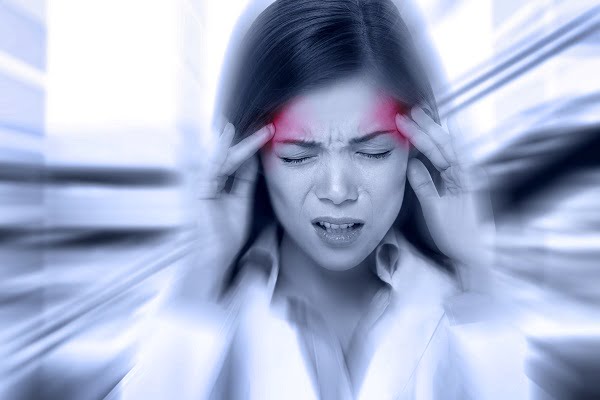
What is migraine?
A migraine is a complex headache disorder characterized by recurrent headaches ranging from moderate to severe. This condition has a wide variety of signs and symptoms but the main feature is a painful and excruciating headache. Such headaches are pulsating in nature, affect one half of the head and last for several hours to days (from 2 to 72 hours).
In some cases, the pain can occur on both sides of your head and may affect the face or neck. Migraine is usually accompanied by nausea, vomiting and extreme sensitivity to light and sound.
Occurrence of migraine: How common is migraine?
A migraine usually begins in early adulthood. Women are more prone to get a migraine than men because of hormonal changes that take place in their body during their lifetime and the stress and strain of their daily life.
One-third Indian women suffer from a migraine as compared to men who have a ratio of one-fifth only.
Some people have migraines more frequently like several times a week. Other people may only have a migraine occasionally. Sometimes the migraine attack may take years to re-appear.
Symptoms of migraine
A migraine has a wide variety of symptoms that can occur:
- a while before a headache
- immediately before a headache
- during a headache
- after a headache
All migraines are not same and typical migraine symptoms include:
- Moderate to severe pain usually covering one side of the head but capable of occurring on either side of the head
- Severe pulsing pain
- Increasing pain during physical activity
- Inability to perform regular activities due to pain
- Feeling sick and vomiting
- Increased sensitivity to light and sound
Some people also experience other symptoms occasionally. But not everyone with a migraine experiences these additional symptoms and some people may also experience them without having a headache. These additional symptoms include:
- Sweating
- Poor concentration
- Feeling very hot or very cold
- Abdominal pain
- Diarrhea
Symptoms of aura
Aura refers to temporary warning symptoms that appear before a migraine. About one-third of people affected by a migraine experience these symptoms. These symptoms develop within five minutes and last for an hour. Some people may experience aura with a mild headache and some may experience aura without a headache.
Aura symptoms include the following:
- Visual problems (such as seeing flashing lights, zigzag patterns of light or blind spots)
- Numbness or a tingling sensation (which usually starts in one hand and moves up eventually affecting the face, lips and tongue)
- Feeling dizzy
- Difficulty speaking
Types of migraine
Broadly, there are three types of migraine, including:
Migraine without aura
This is the most common type of migraine and therefore also known as a common migraine. It occurs without the specific warning signs. Approximately 70-90 percent of migraines occur without an aura.
The main symptom in migraine without aura is a throbbing pain that covers one side of the head. The patients also sometimes experience nausea, vomiting and sensitivity to light and sound.
Migraine with aura
This migraine is also known as a classic migraine. The patient gets an aura before 30 minutes of having a migraine.
Symptoms of aura include flashing lights, seeing distorted objects and a feeling of tingling. About 20 percent of people with migraine experience aura.
Migraine aura without a headache
This type of migraine is also known as a silent migraine. In this type of migraine, an aura or other migraine symptoms are experienced, but a headache does not develop. About 1 percent of migraine patients experience migraine aura without any headache.
Causes of migraine
The exact cause of migraines is not yet known, although researchers suspect that a migraine may result from any of the following factors:
- An underlying disorder of the central nervous system that may give rise to a migraine episode when triggered.
- Irregular brain’s blood vessel system or vascular system may set off migraines.
- A genetic predisposition may be the causal factor of a migraine.
- Any abnormal condition of brain chemicals and nervous system may cause migraine episodes.
Triggers of migraine symptoms
Identifying a trigger is not always easy. Anything can trigger an attack in a person affected by migraine. The factors that can trigger a migraine include:
Hormonal changes
Some women experience migraines during their periods as the levels of hormones like estrogen change. Such migraine lasts for 6-9 days covering the full period. Menopause also triggers migraine in some women.
Emotional triggers
Strong emotions like stress, depression, anxiety, excitement and shock can trigger a migraine.
Physical causes
Physical overexertion, tiredness, insufficient sleep, shoulder or neck tension, jet lag and poor posture may be the reason for a migraine in people.
Triggers in the diet
Alcohol and caffeine contribute at a greater level to trigger migraines. Some specific foods like chocolate, cheese, citrus fruits and foods containing the additive tyramine may cause a migraine.
Sometimes irregular mealtimes and dehydration can also be counted as potential triggers.
Certain medications
Possible triggers in medication include sleeping pills, hormone replacement therapy (HRT) medications and contraceptive pills.
Triggers in the environment
Environmental issues such as high altitude, changes in weather conditions, loud noises and exposure to flickering lights also cause migraine in some people.
Diagnosis of migraine
A migraine is an unpredictable disease. It may occur with different symptoms every time. Therefore diagnosis of a migraine may be a lengthy process.
There is no specific test to diagnose migraines. However, the doctor diagnoses migraine by reviewing the medical and family history of the patient and carrying out some examinations to rule out other causes of the symptoms. Diagnosis of a migraine includes:
Detailed history
A detailed study of the migraine and its symptoms is done in order to analyze:
- The features of the headaches including their occurrence, severity and the symptoms associated.
- How badly the headache affects the everyday activities of the patient.
- The family history of headaches.
- The medical history of the patient including the details of treatment tried in the past, which were not found effective.
Physical and Neurological Exams
Detailed history is followed by a physical exam to look for signs of an illness that may be causing the headaches, such as fever, infection, weakness, speech difficulty and mental confusion.
Next, neurological test is conducted to rule out diseases of the brain or nerves that may also cause headaches and migraines. Those brain diseases include brain tumor, blood clots, hemorrhage, head trauma and blood vessels abnormalities.
Additional tests for diagnosing migraine
These tests are done to look for other medical conditions that may be causing migraines. These tests are listed below:
Blood tests
These tests are done for blood vessel problems, spinal cord or brain infections and toxins in the system.
Urinalysis
This test is done to determine medical conditions like diabetes, hyperthyroidism and certain infections that may cause headaches.
CT (Computerized tomography) Scan
In this test, a series of X-rays is used to create a detailed cross-section of the brain. This test helps to diagnose tumors, infections, brain damage and other possible medical problems that may be causing headaches.
MRI (Magnet resonance imaging)
This test uses a powerful magnetic field along with radio waves and produces detailed images of the brain and blood vessels. The doctors diagnose tumors, strokes, bleeding in the brain, infections and other neurological conditions using this test.
Spinal tap
This test includes removal of spinal fluid from the spinal canal. This is done to rule out the conditions such as infections of the brain or spinal cord.
Treatment of migraine
The treatment process of a migraine depends on the frequency of occurrence of the headaches, their severity, the degree of disability caused and other medical conditions.
The main goal of migraine treatment is to:
- Reduce frequency and severity of the attacks
- Reduce disability
- Improve quality of life
- Prevent future headaches
- Educate and enable patients to manage their disease
Medications for migraine
There are basically two types of medicines given to migraine patients – pain relieving and preventive.
The doctor helps the patient to find out the right medicine based on the severity and frequency of attacks. Pregnant and breastfeeding women should discuss their condition with their doctors before starting any medication.
Pain-relieving medications
This is also known as the abortive treatment. These medicines are taken during migraine attacks as they help to stop symptoms. For best results, these medicines are taken at the first sight of the symptoms. The pain-relieving medications are given below:
Pain relievers
A combination of acetaminophen, aspirin and caffeine is given to relieve pain in migraine.
The side effect of pain relievers is ulcers, gastrointestinal bleeding and medication-overuse headaches (when taken for long periods of time).
Triptans
These medications make the blood vessels constrict and block the pathways in the brain giving some relief in pain. They are available in the form of pills, nasal spray and injection. Sumatriptan, rizatriptan, almotriptan, naratriptan, zolmitriptan, frovatriptan and eletriptan are some of the triptan medications.
Side effects of triptans include reactions at the injection site, nausea, drowsiness and muscle weakness.
Anti-nausea medications
These medicines are usually combined with other medications. Chlorpromazine, metoclopramide and prochlorperazine are some examples of anti-nausea medications.
Opioid medications
Opioid medications are suggested for people who cannot take triptans. These medicines contain narcotics that are habit-forming and are usually used only if no other treatment is found effective.
Glucocorticoids
Prednisone and dexamethasone are the glucocorticoid medications. They are used with other medications for better results in pain relieving. Glucocorticoids shouldn’t be used frequently otherwise they may have side effects.
Preventive medications
These drugs reduce the severity, frequency and length of migraines if taken regularly on a daily basis. They also increase the effectiveness of symptom-relieving medicines used during migraine attacks. The most common medications for migraine prevention include:
Cardiovascular drugs
The beta-blockers like propranolol, metoprolol tartrate and timolol are used for preventing migraines. Other beta-blockers are also sometimes used for the treatment of migraine.
The calcium channel blockers like verapamil may help prevent migraines with aura.
Antidepressants
Tricyclic antidepressants are effective in preventing migraines, even in people without depression. Such drugs reduce the frequency of migraines by affecting the level of serotonin and other brain chemicals.
Amitriptyline is the example of tricyclic antidepressant that is mostly used because it effectively prevents migraines.
The main side effects of these medications are sleepiness, dry mouth, constipation and weight gain.
Anti-seizure drugs
Valproate and topiramate are the anti-seizure medications that are taken to reduce the frequency of migraines.
The side effects of valproate sodium are nausea, tremor, weight gain, hair loss and dizziness. Pregnant women should avoid these medicines.
The side effects of topiramate include diarrhea, nausea, weight loss, memory difficulties and concentration problems.
OnabotulinumtoxinA (Botox)
OnabotulinumtoxinA (Botox) is helpful in treating chronic migraines in adults. This medicine is injected into the forehead muscles and neck muscles and this treatment is repeated every 12 weeks if found effective.
Therapies for migraine treatment
Along with medications, the treatment of migraine also includes some therapies such as:
Progressive muscle relaxation
It is a non-pharmacological method of deep muscle relaxation. It is a process of tensing and relaxing muscle groups starting from head to toe or vice versa.
This process reduces the pain that is caused by migraine. It is done in a series of steps given below:
- Sit in a quiet place and take few deep breaths and exhale slowly.
- Scan the body mentally and try noticing headache and other areas of pain.
- Try to loosen up these areas and try letting go of the tension as much as possible.
- Rotate the head, roll the shoulders and let every muscle of the body relax.
- Recall any pleasant thought or memory.
- Take deep breaths again and exhale slowly.
Acupuncture
In this process, needles are inserted into some specific points on the body. It helps to relieve pain and also treat some conditions. During the process, the needles are inserted up to two inches and remain in the body for 15-20 minutes. Acupuncture helps to:
- Stimulate the body’s natural painkillers
- Increase blood flow
- Stimulate nerves, muscles and tissues
Prevention of migraine
There are a number of ways by which the chances of experiencing migraines can be reduced:
Identifying and avoiding triggers
Identifying the trigger and then avoiding it is the best method to prevent a migraine. Keeping a diary may help to identify the trigger and its effect.
Medication and supplements
Medicines are the next option. They are given when the person is experiencing migraine even after avoiding the triggers. Some of the main medications that are used to prevent migraines are outlined below:
Topiramate
This medicine is taken in tablet form and is effective in preventing migraine. But these medicines should not be given to people with kidney or liver problems and pregnant women. The side effects of topiramate are decreased appetite, nausea, vomiting, constipation or diarrhea and problems in sleeping.
Propranolol
Propranolol is also taken in tablet form every day. These medicines should not be given to people with asthma, diabetes and heart problems. Some of the side effects of propranolol are cold hands and feet, tingling sensation, problems in sleeping and tiredness.
Botulinum toxin type A
Doctor recommends botulinum because it prevents headaches in adults with chronic (long-term) migraine. Botulinum toxin type A is a type of nerve toxin that paralyzes muscles. It is mostly given by injection around the head and back of the neck.
Acupuncture
Acupuncture is opted when medication is unsuitable or it doesn’t help to prevent migraines. Doctors suggest that a course of up to 10-15 sessions over a five to eight week period may be beneficial to prevent a migraine.
Natural remedies for migraines relief
Some home remedies are beneficial for relief in migraine. These are:
Ice Packs
Ice is an anti-inflammatory and is used to treat migraine. Ice packs work by extracting heat from the affected area. They also have a numbing effect, which helps to dull the sensation of throbbing or migraine pain.
Supplements
Vitamin B2 supplements are effective in preventing migraines. The doctors prescribe a dose of 400 mg of vitamin B2 per day. Magnesium is another mineral that should be taken as a supplement by migraine patients. For preventing migraine, a dose of 600 mg of magnesium per day is essential.
Relaxation Techniques
Yoga, massage and tai chi (Chinese martial art) are some techniques that if practiced regularly give relief in migraine symptoms and attacks.
Herbs
An herb butterbur is useful in preventing migraines because it promotes healthy blood flow to the brain. Dry-leaf capsules of feverfew herb also reduce the frequency of migraines.
Acupuncture
This technique provides the same results as drugs and that too without any side effects. Acupuncture helps to prevent migraines by:
- Activating the parasympathetic nervous system
- Decreasing muscle tension






